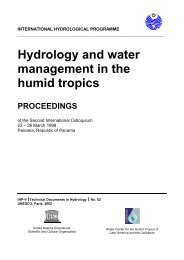FR AB - Science Reference
FR AB - Science Reference
FR AB - Science Reference
You also want an ePaper? Increase the reach of your titles
YUMPU automatically turns print PDFs into web optimized ePapers that Google loves.
<strong>AB</strong>RF 2001 <strong>AB</strong>STRACTS<br />
T5<br />
Technology resource grant opportunities.<br />
M.T. Marron1, M.A. Tingle1, N. Pearson2, M.J. Saunders3; 1NCRR,<br />
NIH, 6705 Rockledge Drive, Bethesda, MD 20892-7965, 2CSR, NIH,<br />
3Natl. Sci. Fndn.<br />
Federal funding is critical for equipping university-based Biomolecular<br />
Resource Facilities with state-of-the-art technologies. In this session, representatives<br />
from two Federal agencies, NSF and NIH, with day-to-day responsibility<br />
for administration of instrumentation grants, will discuss the review<br />
and funding of their various competitive grant programs.<br />
The tutorial session will be split into two parts. The first half of the session<br />
will provide an overview of the various instrumentation programs at NSF and<br />
NIH of interest to <strong>AB</strong>RF members. The second half of the session will focus<br />
on the preview processes at both agencies. Discussion will focus on practical<br />
tips on how to prepare a successful NSF and NIH proposal. Formal presentations<br />
will be followed by a question and answer period.<br />
T7<br />
Advances in DNA sequencing.<br />
L.S. Hall1, E. Thomas1, K. Lilley2, G. Grills1; 1Albert Einstein Col. of Med.,<br />
1695 Poplar Street, NewYork, NY 10464, 2Cambridge Univ.<br />
This tutorial will review past advances in DNA sequencing and present new<br />
techniques for sequencing difficult templates. Significant advances have<br />
taken place in DNA sequencing in the past four years by virtue of improved<br />
instrumentation, advances in the sequencing chemistries and alternative reaction<br />
formats for sequencing difficult clones. In particular, the replacement of<br />
Rhodamine terminators with Big Dye terminators increased the range of signal<br />
strengths compatible with good data and eliminated many of the peak<br />
height errors associated with rhodamine terminators; such as base calling<br />
ambiguities linked to the pattern of a small ‘G’ following an ‘A’.<br />
The recent introduction of dGTP terminators has improved the quality of data<br />
from templates with high GC content or regions of secondary structure.<br />
Data will be presented demonstrating the effectiveness of dGTP compared<br />
to Big Dye. In addition, the efficacy of betaine (NNN Trimethylglycine) versus<br />
DMSO will be discussed. New data will be presented demonstrating that<br />
a combination of Big dye and dGTP can sequence through regions of high<br />
G-C content without incurring compressions, a disadvantage of dGTP terminators<br />
by themselves.<br />
Finally, studies are in progress to evaluate the ability of different techniques<br />
to sequence through various types of difficult motifs by addition of commercial<br />
additives, such as the new GIBCO Rx Enhancer buffers. In general<br />
difficult motifs, such as repeats, induce stalling of Taq and loss of signal<br />
beyond the offending region. Depending upon the type of template, these<br />
buffers can restore the processivity of the enzyme and resolve regions of secondary<br />
structure. Results will be presented from studies that identify combinations<br />
of additives that work well with particular motifs.<br />
TUTORIAL <strong>AB</strong>STRACTS<br />
230 JOURNAL OF BIOMOLECULAR TECHNIQUES, VOLUME 11, ISSUE 4, DECEMBER 2000<br />
T6<br />
Advances in DNA sequencing.<br />
M.A. Robertson; Univ. of Utah, 4A 438 School of Medicine,<br />
50 N. Medical Drive, Salt Lake City, UT 84132<br />
The Human Genome Project has been a major driving force for the development<br />
of new instrumentation and methodology for high throughput<br />
sequencing. During the last five years we have seen major advances both in<br />
instrumentation and sequencing chemistries. This tutorial will present user<br />
insight into one of the newer capillary instruments that promises to fit well<br />
into a core laboratory setting. The tutorial will also look at the changes in sequencing<br />
chemistry and present some solutions for difficult templates using<br />
these new chemistries. This tutorial is designed to be interactive. There will<br />
be a 30 minute question/answer session after the two main speakers, with a<br />
panel comprising the speakers and members of the DNA Sequencing Research<br />
Group. Please come armed with your most difficult sequencing problems<br />
and help spark a lively discussion session.<br />
T8<br />
Incorporating a 16 capillary electrophoresis DNA sequencer<br />
into a core facility.<br />
P.T. Morrison; Dana-Farber Cancer Inst., 44 Binney St., JFB216,<br />
Boston, MA 02115<br />
In the past few years the Human Genome Project (HGP) has driven innovation<br />
in DNA sequencing chemistry and instrumentation. For the most part this<br />
has been beneficial for all types of DNA sequencing projects both large and<br />
small. Recently manufacturers are now filling a void for instrumentation that<br />
is better suited for facilities that sequence less than 100,000 templates per<br />
year.<br />
The incorporation of an Applied Biosystems Model 3100 Genetic Analyzer<br />
into a core facility environment will be discussed.















